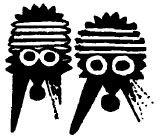The 12th Planet (21 page)
Authors: Zecharia Sitchin
Tags: #Non-Fiction, #Gnostic Dementia, #Fringe Science, #Retail, #Archaeology, #Ancient Aliens, #History

The ancient texts indicate that the gods put on such special attire not only for their flights in Earth's skies but also when they ascended to the distant heavens. Speaking of her occasional visits to Anu at his Celestial Abode, Inanna herself explained that she could undertake such journeys because "Enlil himself fastened the divine ME-attire about my body." The text quoted Enlil as saying to her:
You have lifted the ME,
You have tied the ME to your hands,
You have gathered the ME,
You have attached the ME to your breast....
O Queen of all the ME, O radiant light
Who with her hand grasps the seven ME.
An early Sumerian ruler invited by the gods to ascend to the heavens was named EN.ME.DUR.AN.KI, which literally meant "ruler whose
me
connect Heaven and Earth." An inscription by Nebuchadnezzar II, describing the reconstruction of a special pavilion for Marduk's "celestial chariot," states that it was part of the "fortified house of the seven
me
of Heaven and Earth."
The scholars refer to the
me
as "divine power objects." Literally, the term stems from the concept of "swimming in celestial waters." Inanna described them as parts of the "celestial garment" that she put on for her journeys in the Boat of Heaven. The
me
were thus parts of the special gear worn for flying in Earth's skies as well as into outer space.
The Greek legend of Icarus had him attempt to fly by attaching feathered wings to his body with wax. The evidence from the ancient Near East shows that though the gods may have been depicted with wings to indicate their flying capabilities—or perhaps sometimes put on winged uniforms as a mark of their airmanship—they never attempted to use attached wings for flying. Instead, they used vehicles for such travels.
The Old Testament informs us that the patriarch Jacob, spending the night in a field outside of
H
aran, saw "a ladder set up on Earth and its top reaching heavenwards," on which "angels of the Lord" were busily going up and down. The Lord himself stood at the top of the ladder. And the astounded Jacob "was fearful, and he said":
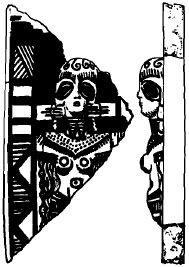
Fig. 61
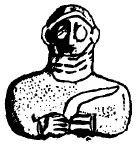
Fig. 62
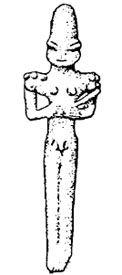
Fig. 63
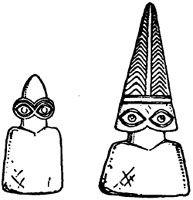
Fig. 64

Fig. 65
Indeed, a God is present in this place,
and I knew it not....
How awesome is this place!
Indeed, this is none but the Lord's Abode
and this is the Gateway to Heaven.
There are two interesting points in this tale. The first is that the divine beings going up and down at this "Gateway to Heaven" were using a mechanical facility—a "ladder." The second is that the sight took Jacob by complete surprise. The "Lord's Abode," the "ladder," and the "angels of the Lord" using it were not there when Jacob lay down to sleep in the field. Suddenly, there was the awesome "vision." And by morning the "Abode," the "ladder," and their occupants were gone.
We may conclude that the equipment used by the divine beings was some kind of craft that could appear over a place, hover for a while, and disappear from sight once again.
The Old Testament also reports that the prophet Elijah did not die on Earth, but "went up into Heaven by a Whirlwind." This was not a sudden and unexpected event: The ascent of Elijah to the heavens was prearranged. He was told to go to Beth-El ("the lord's house") on a specific day. Rumors had already spread among his disciples that he was about to be taken up to the heavens. When they queried his deputy whether the rumor was true, he confirmed that, indeed, "the Lord will take away the Master today." And then:
There appeared a chariot of fire,
and horses of fire....
And Elijah went up into Heaven
by a Whirlwind.
Even more celebrated, and certainly better described, was the heavenly chariot seen by the prophet Ezekiel, who dwelt among the Judaean deportees on the banks of the Khabur River in northern Mesopotamia.
The Heavens were opened,
and I saw the appearances of the Lord.
What Ezekiel saw was a Manlike being, surrounded by brilliance and brightness, sitting on a throne that rested on a metal "firmament" within the chariot. The vehicle itself, which could move whichever way upon wheels-within-wheels and rise off the ground vertically, was described by the prophet as a glowing whirlwind.
And I saw
a Whirlwind coming from the north,
as a great cloud with flashes of fire
and brilliance all around it.
And within it, from within the fire,
there was a radiance like a glowing halo.
Some recent students of the biblical description (such as Josef F. Blumrich of the U.S. National Aeronautics and Space Administration) have concluded that the "chariot" seen by Ezekiel was a helicopter consisting of a cabin resting on four posts, each equipped with rotary wings—a "whirlwind" indeed.
About two millennia earlier, when the Sumerian ruler Gudea commemorated his building the temple for his god Ninurta, he wrote that there appeared to him "a man that shone like Heaven ... by the helmet on his head, he was a god." When Ninurta and two divine companions appeared to Gudea, they were standing beside Ninurta's "divine black wind bird." As it turned out, the main purpose of the temple's construction was to provide a secure zone, an inner special enclosure within the temple grounds, for this "divine bird."
The construction of this enclosure, Gudea reported, required huge beams and massive stones imported from afar. Only when the "divine bird" was placed within the enclosure was the construction of the temple deemed completed. And, once in place, the "divine bird" "could lay hold on heaven" and was capable of "bringing together Heaven and Earth." The object was so important—"sacred"—that it was constantly protected by two "divine weapons," the "supreme hunter" and the "supreme killer"—weapons that emitted beams of light and death-dealing rays.
The similarity of the biblical and Sumerian descriptions, both of the vehicles and the beings within them, is obvious. The description of the vehicles as "bird," "wind bird," and "whirlwind" that could rise heavenward while emitting a brilliance, leaves no doubt that they were some kind of flying machine.
Enigmatic murals uncovered at Tell Ghassul, a site east of the Dead Sea whose ancient name is unknown, may shed light on our subject. Dating to circa 3500
B.C.
, the murals depict a large eight-pointed "compass," the head of a helmeted person within a bell-shaped chamber, and two designs of mechanical craft that could well have been the "whirlwinds" of antiquity. (Fig. 66)
